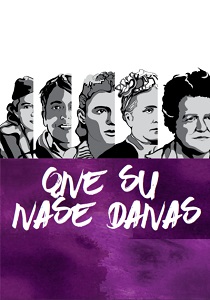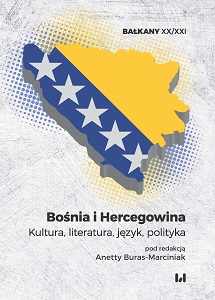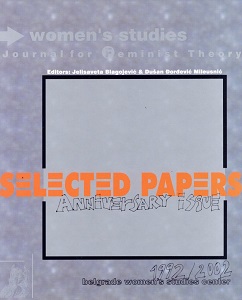
We kindly inform you that, as long as the subject affiliation of our 300.000+ articles is in progress, you might get unsufficient or no results on your third level or second level search. In this case, please broaden your search criteria.


The article describes the role of social media in the presentation of gender issues on the basis of the example of Caitlyn Jenner. It is not only the story of a public figure, in addition a transgender one, who underwent a successful transformation into a woman. It is also the story of an extraordinary media campaign that makes use of the most of the available tools of the traditional media and Web 2.0 tools, in order to reach the widest possible audience and build a completely new image of a forgotten American hero and a supporting star of the worldwide popular reality show.
More...
Dolaskom austrougarske uprave počinje modernizacija društva bez dubljeg zadiranja u društveni ili bilo koji drugi položaj žene, ali otvaraju se nove mogućnosti i horizonti kombiniranjem starih i novih običaja. Austrougarski period karakterizira ukrštanje tradicionalnog i modernog, stranog i domaćeg, a proturječnosti ovih ukrštanja su se odrazile i na same žene, u slučaju da su i same bile akterke brojnih događaja ili dio opće populacije.
More...
U ratnom periodu (1992-1995), kao i poraću, brojne značajne žene iz različitih sfera javnog života ostavile su svoj trag Ovaj rat, kao i drugi u povijesti čovječanstva, bio je muška priča, u kojoj su žene sudjelovale na različite načine, ali najčešće po strani. Žene su imale simbolične uloge: mirotvorke, aktivistkinje, nemoćne i pasivne žrtve. Ukratko, bile su suprotnost muškom ratu. Stvarna uloga žene u ratu je bila uistinu ovakva, ali i mnogo više od toga. Prve žrtve rata su uvijek bile žene, jer je njih direktno pogađao raspad sistema, te je briga za obitelj i društvo ostajala na njima. Zabilježeno je mnogo slučajeva kršenja ljudskih prava, pogotovo ženskih, na veoma specifične načine. No, rat u BiH je bio konflikt koji je ujedno uticao i na osnaživanje žena. S obzirom na to da su mnogi muškarci bili mobilizirani i nisu se mogli kretati slobodno jer su sudjelovali u vojsci, skoro čitav javni prostor je bio ostavljen ženama. Žene su uspjele preoblikovati tradicionalne uloge koje su bile društveno propisane za žene i muškarce, što je pojačalo žensko samopouzdanje. Istaklo se mnogo novih žena vođa, koje su i sa završetkom rata nastavile ispunjavati svoje uloge.
More...
Naša današnjica i crtice iz života žena osvjetljavaju one koje nastavljaju borbu za jednakost i pokreću neke nove bitke za feminističke i aktivističke ciljeve. Te snažne žene ostavljaju novim generacijama prostor i uzore čije stope treba nastaviti i slijediti.
More...
The formal and legal aspects of gender equality in BiH need tobe seen through two levels - international and national, which have their own reflections on the other levels including the lowest level - the local community. For the needs of this research, here are some of the most important ones: The CEDAW Convention (the Convention on the Elimination of All Forms of Discrimination against Women, 1979), the Beijing Declaration and the Action Platform (1995), Resolution 1325 ("Women, Peace and Security", 2000) and the Council of Europe Convention on the Prevention and Combating Violence against Women and Domestic Violence (2011, the so-called Istanbul Convention). Regarding domestic legislation, it is necessary to emphasize the importance of the Gender Equality Law in BiH and the Anti-Discrimination Law in BiH.
More...
The subject of the article is collection of Šejla Šehabović’s short stories A Plural Noun of Feminine Gender (Priče – ženski rod, množina) as an example of the women’s Bosnian (anti)war prose. The stories are interpreted by analysing trauma present in narratives, ways in which traumatic memories are remembered and how the memories are presented in a story. Particular attention is devoted to the narrative itself, which in many aspects is viewed as a form of articulation of trauma. The analysis focuses on the feminine perspective in war experience as well as its differences from previous predominantly masculine narratives. The article indicates the relationship between traumatic narrative, literature of testimony and women’s writing.
More...
Autorica piše o složenom odnosu između roda (žena) i prirode (u najširem smislu te riječi obuhvaćajući sva živa bića) naglašavajući važnost povezivanja ovih tema. Ključna je postavka promjena paradigme promišljanja o rodnim i prirodnim (»okolišnim «) temama, što će dovesti do stvarnih praktičnih promjena. Time bi se redefinirale tradicionalne uloge žena, prirode I svega na što se odnosi termin Drugi.
More...
Experience over several centuries of discrimination and exploitation led to consideration about the connection between female and animal issues, even before ecofeminist theory. The dominant patriarchal structure of the world reduced both women and animals to objects with little or no power at all, positioning women as the ones closer to nature and animals (what is non–human can be maltreated and abused). Feminists in the animal rights movement experience differently the involvement of women and women’s bodies in the fight for animal rights, thus showing that heterogeneousness in evaluation of the methods being used in the fight against oppression also exists within the same interest group. Whilst some think that animal liberation over female bodies is not justified and that such a practice dehumanizes women and encourages a misogynous view of them, others think that being involved in actions like Rather go naked than wear fur leads to re–evaluation of ethical and moral issues and enables engagement in more important and efficacious political action. The identities of animal rights activists are being formed through a polyphony of feminist voices, agreeing that the consistently raised issue of women rights in modern times also raises issues about animal rights.
More...
Women were prominent within the anti-war movements and pacifist circles throughout history-even when the wars they opposed were widely considered holy, as in the Middle Ages.1 Closer to our time, there was a high presence of women in both 19th- and 20th-century pacifist and anti-war movements. Finally, the notable prevalence of women in peace movements on different sides involved in the Yugoslav War-in Belgrade, Zagreb and Sarajevo-was one of the more conspicuous features of this conflict.
More...


The right of women to vote and be elected is the output of a difficult and long-term struggle. In Turkey, women won the right to vote and be elected in 5 December, 1934. The Swiss women were 36 years later, in 1971. In 2021, the rate of female deputies in the Turkish Grand National Assembly is 17.2% and in Switzerland it is 42%!Although the number of female MPs in the Turkish Grand National Asembly reached the highest rate (17.8%) in the June 2015 elections, it has been decreasing since 2015. It is seen that there is no positive situation regarding equal representation of women in decision-making mechanisms and the current situation is below the global average. In order to ensure equal participation of women and men in socio-economic life, it is critical that the government implements gender equality policies and that the selected women create pressure on this issue.In this study, the programs, statutes and election manifestos of 11 parties (AK Party, BTP, BBP, CHP, DP, HDP, IYI Party, MHP, SP, VP and HÜDA-PAR) that entered the 27th term parliamentary elections will be analyzed in a gender equality perspective. However, the data of the parties on women's representation during the election period and the election results will be evaluated comprehensively.
More...
This paper contains research on the traces left in social memory by a monument built in public space by the sculpture artist Meriç Hızal in order to express the reaction that she felt against femicides. The “Alyazma Monument”, which was built in cooperation with the Antalya City Council's Women Assembly and the Muratpaşa Municipality, was opened on 07 March 2012 in the Palmiye Park in Muratpaşa district. This monument, built on the concept of femicide, represents women killed by male violence. The artist who designed the “alyazma” form using the concept of a red metal pyramid in order to symbolize the women who were killed in Anatolia, carved the names of women who had been victims of violence and thus let the light leak from the holes of the characters. The fact that the light passing through the female names carved on Alyazma falls on the people entering the monument creates an intense state of emotion for the people who experience this artwork. The audience, upon seeing these names, shivers and feel a confrontation with these murders. Thanks to the light that leak from these names, the names of female victims are reflected on the ground, and visitors do not want to step on the names reflected on the ground.The aestheticization of a social pain in a pyramidal monument form invokes a thought-provoking, questioning feeling within the viewers. When it rains, the raindrops that slide from the cavities are identified with the tears of the deceased women. Can a work of art leave a trace in social memory? Is art merely an area of aesthetic pleasure experience? The paper will be developed on these questions and an evaluation will be made in the conclusion section.
More...
ARE ACTING THEORY AND HISTORY GENDER-INFLECTED DISCOURSES, HAVING IN MIND ACTING’S MAIN VEHICLE OF EXPRESSION – THE HUMAN BODY – AND THE CONCOMITANT FACT THAT SEPARATE CHAPTERS OF ACTING THEORY AND HISTORY NECESSARILY, IF IMPLICITLY, RELIED ON PHILOSOPHICAL AND MEDICAL, LATER ALSO PSYCHOLOGICAL AND SOCIOLOGICAL CONCEPTUALISATIONS OF SEXUAL DIFFERENCE? THIS ARTICLE OFFERS A SHORT SURVEY OF SHIFTING HISTORICAL IDEAS REGARDING THE FEMALE ACTING PRACTICE AS AN EITHER NEGLECTED OR OVERVALUED, “INDOMITABLE” SUPPLÉMENT DISTURBING ALL ATTEMPTS TO CONSTRUCT A UNIFIED AESTHETIC, HISTORICAL AND THEORETICAL DISCOURSE ON ACTING, LET ALONE THE ONE WHICH WOULD PROVE INDEPENDENT OF WHAT BOURDIEU CALLS THE HISTORICAL LABOUR OF DEHISTORICIZING THE PROCESS OF OVERALL SEXUALISATION OF COGNITIVE AND SOCIAL STRUCTURES ACCORDING TO CATEGORIES DERIVED FROM THE ANDOCENTRIC UNCONSCIOUS.
More...
THE FICTION OF GENDER CONSTRUCTING THE FICTION OF NATION: ON HOW FICTIONS ARE NORMATIVE, AND NORMS PRODUCE EXCEPTIONS, “NATION”, CLAIMING AN IMAGINARY COMMON BIRTH, RECONSTRUCTS ITSELF A POSTERIORI AS A REALITY AS IF IT HAD ALWAYS EXISTED. IT NEEDS PATRIARCHY FOR THIS. BOTH THE GENDER DIVISION, AS WELL AS THE EXCLUSION ON WHICH THE NATION IS ESTABLISHED, THOUGH CAUSALLY INTERTWINED, EXPRESS THE SAME UNIVERSAL "SHARING/SPLITTING OF REASON" (PARTAGE DE LA RAISON). BOTH CLAIM “NATURE” ESSENTIALISING THE INEQUALITY AS NATURAL. REASON IS NORMATIVE, ESPECIALLY IN ITS DIVIDED FORM. THE SEX (OR GENDER) DIFFERENCE IS POLITICAL. IT IS THE POLITICAL DIFFÉREND REPRESENTING THE HETEROSEXUAL NORMATIVE PARADIGM THROUGH SYMBOLIC ANALOGIES, FOR OTHER INJUSTICES AND INEQUALITIES. IT IS A HIERARCHY INCLUDING WOMEN AS SUBORDINATE. IT IS THE DICHOTOMY THAT FIXES GENDER AND SEX, NOT THE OPPOSITE. THE SEXUAL DIFFERENCE IS A VERY POWERFUL IDEA SHOWING THE INADEQUACY OF THE SELF WITH ITSELF.
More...
IF WE UNDERSTAND SELF AS A COMPLEX CONSTRUCTION, EXPRESSED AND CREATED THROUGH THE PROCESS OF SELF-REPRESENTING AND THAT THE ESSENTIAL GENRE OF SELF-REPRESENTING IS NARRATIVE, THE IDENTITY WILL APPEAR AS A MATTER OF RELATIONS MADE WITHIN OUR LINGUISTIC COMMUNITY, NOT OF SOME “PRIMORDIAL SUBJECT” TO WHICH ALL INDIVIDUAL IDENTITIES SHOULD RESPOND. THAT'S WHY INTROSPECTION, TENDING TO FIND SOME "REAL GROUND OF THE SELF" SEEMS HOPELESS… TWO EXTREME EXAMPLES IN SERBIAN MEDIEVAL HISTORY AND MYTHOLOGY ILLUSTRATE THE ROLE OF WOMAN AS A REAL TRAUMATIC ONE WITHIN THE SYMBOLIC CONSTRUCTION. THE FIRST ONE IS THE WELL KNOWN MYTH THE BUILDING OF SKADAR – ALREADY FULLY ANALYZED IN BRANKA ARSIĆ'S TEXT "QUEER SERBS" –AND THE SECOND IS A HISTORICAL PERSON – DAMNED JERINA. IN BOTH CASES, THE TOPIC IS THE BUILDING OF A TOWN/FORTRESS AND THE KEY ROLES ARE GIVEN TO WOMEN. WHAT I WOULD LIKE TO PROBLEMATIZE HERE, RELATED TO THESE EXAMPLES, IS THE MANIPULATION WITH GUILT IN STRUCTURING THE FEMALE IDENTITY AND TO TRY TO SHOW HOW THIS PROJECTION OF GUILT TO THE OTHER FIGURED IN THE EX-YUGOSLAV CONFLICT AND POLITICAL DISCOURSE.
More...
THIS ARTICLE DEALS WITH QUESTIONS CONCERNING THE NATURE OF THE REPRESENTATION OF THE FEMALE BODY WITHIN THE SO-CALLED “ORIENTAL” DISCOURSE IN SERBIAN ART: WHO IS THE PAINTER? FOR WHOM IS THE WORK PAINTED? WITH WHOM IS THE WORK IDENTIFIED? WITH WHAT OTHER POSSIBILITIES OF IDENTIFICATION DOES THE WORK LEAVE US? IN THE CONTEXT OF THE HISTORICAL CODES, A STANCE TOWARDS A BODY IS SEEN AS A PROJECTION OF SOCIAL, CULTURAL AND POWER IMPULSES. IN THE FIRST CASE STUDIED, THE ARTIST, DJORDJE KRSTIC, WAS A MALE COMMISSIONED BY THE SERBIAN COURT TO PAINT A SERIES OF PAINTINGS FOR THE INDIGENOUS POPULATION AND FOREIGNERS. IN THE SECOND CASE STUDY, THE ARTIST, PAJA JOVANOVIC, WAS ALSO A MALE, A SERB WORKING IN VIENNA, WHO PAINTED FOR THE AUDIENCE OF THE “REAL EUROPE” FROM THE POSITION OF AN ALTERNATIVE IDENTITY. THE THIRD CASE STUDY FOCUSES ON A FEMALE ARTIST, BABETT BACHMAYER VUKANOVIC, WHO WAS BORN IN GERMANY BUT AFTER MARRYING A SERB MOVED TO HER HUSBAND’S HOMELAND. VISUAL CONSTRUCTIONS OF FEMALE BODIES ARE USED AS THE STARTING POINT FOR THE DECONSTRUCTION OF GENDER-RELATED QUESTIONS WHICH HAVE BEEN IGNORED IN THE ANALYSIS OF THE ÉPOQUE.
More...
THE PAPER EXAMINES THE SOCIAL, POLITICAL, LEGAL AND CULTURAL CONSTRUCTIONS OF WOMAN’S IDENTITY IN POST- WORLD WAR 2 SLOVENIA. IN FORMER YUGOSLAVIA, SOCIALIST DOCTRINE DISASSOCIATED ITSELF SHARPLY FROM WESTERN FEMINISM THAT IT SAW AS AN IDEOLOGICAL OUTLET OF THE BOURGEOIS CONSCIOUSNESS. INSTEAD, THE »WOMAN'S QUESTION« WAS PROMOTED AS, IN THE WORDS OF THE LEADING POST-WAR SLOVENE IDEOLOGUE VIDA TOMSIC, AN INTEGRAL QUESTION OF OVERALL MATERIAL AND SOCIAL PROGRESS. HOWEVER, SCHOLARS OF GENDER IN THE FORMER SOCIALIST BLOC HAVE ARGUED THAT IN THE EFFORTS TO CONTROL WOMEN'S ROLE IN SOCIETY, THE OFFICIAL DISCOURSE AND POLITICS CREATED A SPECIFIC SOCIALIST DICHOTOMY BETWEEN THE PRIVATE AND THE PUBLIC SPHERE WHICH WAS THE EXACT OPPOSITE OF THE WESTERN SOCIETIES: WHEREAS IN THE WEST, THE FEMINIST DISCOURSES LOCATED THE PUBLIC SPHERE AS THE SITE OF THE STRUGGLE FOR GENDER EQUALITY, AND STROVE TO LIBERATE WOMAN FROM HER »DOMESTIC CONTAINMENT«, IN THE SOCIALIST SOCIETY, IT WAS THE PRIVATE SPHERE WHICH PRESENTED ITSELF AS A SPHERE OF FREEDOM AND RESISTANCE. ISOLATED FROM STATE IMPOSED POLITICS OF »WOMAN'S LIBERATION« IN THE WORKPLACE, THE SPHERES OF FAMILY LIFE AND DOMESTICITY OFFERED TO WOMEN AN IDEOLOGICAL SANCTUARY TO CONSTRUCT THEIR OWN IDENTITIES AS WELL AS A TERRAIN TO CONTEST THE SOCIALIST PARADIGM OF WOMANHOOD. THE PAPER LOOKS AT THE IDEOLOGICAL AND CULTURAL COMPLEXITIES OF THIS DICHOTOMY OF GENDER FROM THE SPECIFIC VANTAGE POINT OF SOCIALIST SLOVENIA. IT DEFINES A DISTINCT GEO-POLITICAL AND ECONOMIC POSITION OF SLOVENIA AND DISCUSS THE INFLUENCE OF PARTY IDEOLOGY IN WHICH EYES WOMEN WERE MORE OR LESS ONLY COMRADES AND WORKING MOTHERS ON THE ONE SIDE AND WESTERN FEMINISM WHICH THESE WOMEN MOSTLY SAW AS DOUBLE-BURDENED AND DE-FEMINISED WOMEN ON THE OTHER AS WELL AS THEIR MULTI-CULTURAL EXPERIENCES OF EVERYDAY LIVES ON THE CONSTRUCTION OF WOMEN'S IDENTITY. IT ALSO ADDRESSES THE ROLE OF MASS CULTURE AND CONSUMERISM AS IMPORTANT SITES OF CONTESTATION AVAILABLE TO WOMEN IN THEIR DAILY LIVES ESPECIALLY THROUGH ADVERTISING AND WOMEN'S MAGAZINES. THE PAPER OBSERVES IDEOLOGICAL CLASHES BETWEEN SOCIALIST IDEOLOGY AND THE WESTERN-STYLE IMAGERY AS THEY STRUGGLE TO DEFINE WOMAN'S IDENTITY UNDER THE GROWING PRESSURE OF LIBERALIZATION AND DEMOCRATIZATION OF SOCIETY.
More...
THE PAPER FOCUSES ON THE THE POSITION OF SON/NARATOR IN CONTEMPORARY SERBIAN NOVEL. ALTHOUGH STILL THE PRIVILEGED INHERITOR OF ALL SYMBOLIC GOODS OF PATRIARCHAL COMMUNITY, THE SON/NARATOR IS NO LONGER IN AN ABSOLUTELY DESIRABLY BUT IN A MARGINAL AND OUTSIDERISH POSITION WHICH REVEALS SIGNIFICANT CULTURAL SHIFTS AND SPECIFIC INTERACTIONS BETWEEN POSTMODERN NARRATIVE STRATEGIES AND REPRESENTATIONS OF NEW CONCEPTS OF MASCULINITIES IN SERBIAN CULTURE.
More...